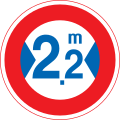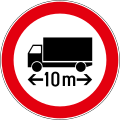Prohibitory traffic sign

This article needs additional citations for verification. (July 2008) |
Prohibitory traffic signs are used to prohibit certain types of manoeuvres or some types of traffic.
Modern prohibitory traffic signs
[edit]No entry
[edit]No admittance to unauthorised personnel, usually shown as a red circle with a white rectangle across its face. It is often used for one-way traffic.
-
Australia
-
Belgium
-
Bosnia and Herzegovina, Croatia
-
Botswana, Eswatini, Lesotho, Namibia, South Africa, Tanzania, Zimbabwe
-
Bulgaria
-
Canada
-
China (Mainland)
-
China (Hong Kong)
-
Costa Rica
-
Denmark
-
Finland
-
France
-
Germany
-
Greece
-
Hungary
-
India
-
Indonesia
-
Iran
-
Ireland
-
Japan
-
Mexico (Jalisco)
-
Moldova
-
Mongolia
-
New Zealand
-
Norway
-
Peru
-
Philippines
-
Poland
-
Russia, Armenia, Azerbaijan, Belarus, Georgia, Kazakhstan, Lithuania
-
Sweden
-
Thailand
-
Ukraine
-
United Kingdom, Malta
-
United States
-
South Korea
-
Italy
-
Estonia
Wrong way
[edit]These signs denote that the road is only for traffic coming in the opposite direction. Used at intersections to roads with one-way traffic or ramps.
-
Australia
-
Austria
-
Canada
-
Ireland
-
Thailand
-
Norway
-
Poland
-
United States
-
Costa Rica
-
New Zealand
-
Croatia
Road closed
[edit]No admittance for vehicles. It is used on closed roads.
-
Canada
-
China (Mainland)
-
China (Hong Kong)
-
Croatia
-
Most European countries
-
Germany
-
Japan
-
Moldova
-
New Zealand
-
Russia
-
United States
-
Ukraine
-
Czechia
No straight ahead
[edit]Traffic is not permitted to continue straight, and must usually turn. These may occur at an intersection with incoming one-way traffic.
-
China (Mainland)
-
Ireland
-
Mexico
-
Mexico (Jalisco)
-
United States
-
Canada
-
India
-
Thailand
-
Chile
-
Costa Rica
-
Brazil
-
South Korea
No motor vehicles
[edit]Motor vehicles are not permitted in this region.
-
Austria
-
Belgium
-
China (Mainland)
-
China (Hong Kong)
-
Croatia
-
Czech Republic
-
France
-
Germany
-
Greece
-
Hungary
-
Indonesia
-
Italy
-
Latvia
-
Mexico
-
Mexico (Jalisco)
-
Netherlands
-
Norway
-
Poland
-
Russia
-
Sweden
-
Turkey
-
United Kingdom
-
United States
-
Japan
-
India
-
Iran
-
Jamaica
-
Jamaica
-
Moldova
-
Nepal
-
SADC
[clarification needed] -
Iran
No motorcycles
[edit]Motorcycles are not permitted in this area.
-
Austria
-
Belgium
-
China (Mainland)
-
China (Hong Kong)
-
Croatia
-
Czechia
-
France
-
Germany
-
Greece
-
Hungary
-
Indonesia
-
Italy
-
Latvia
-
Mexico
-
Netherlands
-
Norway
-
Poland
-
Russia
-
Sweden
-
Turkey
-
United Kingdom
-
United States
-
Iran
-
Jamaica
-
Moldova
-
SADC
-
South Korea
No heavy goods vehicles
[edit]Heavy goods vehicles are not allowed.
-
Armenia
-
Australia
-
Austria
-
Belgium
-
Bulgaria
-
Canada
-
Canada (Québec)
-
China (Mainland)
-
Croatia
-
Czech Republic
-
Estonia
-
France
-
Germany
-
Greece
-
Hungary
-
Indonesia
-
Italy
-
Latvia
-
Mexico
-
Mexico (Jalisco)
-
Moldova
-
Netherlands
-
New Zealand
-
Norway
-
Philippines
-
Poland
-
Slovakia
-
Sweden
-
United Kingdom
-
United States
-
Russia
-
Romania
-
South Korea
-
SADC
-
Uganda
-
Ukraine
-
Jamaica
No buses
[edit]Buses are not permitted.
-
Australia
-
Austria
-
Belgium
-
China (Mainland)
-
Croatia
-
Estonia
-
France
-
Germany
-
Greece
-
Hungary
-
Italy
-
Netherlands
-
Poland
-
Portugal
-
Russia
-
Slovakia
-
South Korea
-
Switzerland, Liechtenstein
-
Turkey
-
United Kingdom
-
Thailand
No pedestrians
[edit]Pedestrians are not allowed on the road, but may use a footpath instead.
-
Australia
-
Austria
-
Belgium
-
Bulgaria
-
Canada
-
China (Mainland)
-
Czechia
-
Estonia
-
France
-
Germany
-
Greece
-
Hungary
-
Italy
-
Mexico
-
Mexico (Jalisco)
-
Netherlands
-
Norway
-
Philippines
-
Philippines (use overpass)
-
Philippines (use pedestrian crossing)
-
Poland
-
Russia, Armenia, Azerbaijan, Belarus, Georgia, Kazakhstan, Mongolia
-
Slovakia
-
Sweden
-
United Kingdom
-
Ukraine
-
United States
-
Kyrgyzstan
-
New Zealand
-
Iran
-
Croatia
-
Lithuania
-
SADC
-
Chile
-
Nepal
-
Jamaica
-
Iran
No bicycles
[edit]-
Austria
-
China (Mainland)
-
Indonesia
-
Mexico
-
Mexico (Jalisco)
-
Netherlands
-
United Kingdom
-
Russia
-
New Zealand
-
Ukraine
-
Japan
-
Australia
-
Moldova
-
SADC
-
Germany
-
Hungary
-
Poland
-
Croatia
-
Jamaica
-
Greece
-
Iran
No pedestrians or bicycles
[edit]Pedestrians and bicycles are not permitted, but may be allowed on a footpath.
-
Canada
-
China (Hong Kong)
-
Germany (unofficial)
-
Norway
-
United States
-
United States (also no motor-driven cycles are allowed[1])
-
SADC
-
Australia
No right, left, or U-turn
[edit]Either for all vehicles or with some exceptions (emergency vehicles, buses). These are usually to speed up traffic through an intersection or due to street cars or other rights of way or if the intersecting road is one-way. Indicated near-universally by an arrow making the prohibited turn overlaid with a red circle with an angular line crossing it.
No right turn signs
[edit]-
Australia
-
Botswana, Eswatini, Lesotho, Namibia, South Africa, Tanzania, Zimbabwe
-
China (Mainland)
-
France
-
Indonesia
-
Mexico
-
Mexico (Jalisco)
-
New Zealand
-
Norway
-
Philippines
-
Poland
-
Saudi Arabia
-
Sweden
-
United Kingdom
-
United States, Canada
-
Russia
-
Ukraine
-
Ireland
-
Moldova
-
South Korea
-
Croatia
-
Thailand
-
Iran
No left turn signs
[edit]-
Australia
-
Botswana, Eswatini, Lesotho, Namibia, South Africa, Tanzania, Zimbabwe
-
China (Mainland)
-
France
-
Mexico
-
Mexico (Jalisco)
-
New Zealand
-
Norway
-
Philippines
-
Poland
-
Sweden
-
United Kingdom
-
United States, Canada
-
Russia
-
Ukraine
-
Ireland
-
Moldova
-
South Korea
-
Croatia
-
Thailand
-
Iran
No turn signs
[edit]-
Andorra
-
Canada
-
China (mainland)
-
United States
No U-turn signs
[edit]-
Australia
-
Botswana, Eswatini, Lesotho, Namibia, South Africa, Tanzania, Zimbabwe
-
China (Mainland)
-
France
-
Indonesia
-
Ireland
-
Mexico
-
Mexico (Jalisco)
-
Netherlands
-
New Zealand
-
Norway
-
Philippines
-
Poland
-
Saudi Arabia
-
Sweden
-
United Kingdom
-
United States
-
Caltrans (Left turn on green arrow)
-
Russia
-
Ukraine
-
Japan
-
Germany
-
Hong Kong
-
Denmark
-
Moldova
-
South Korea
-
Croatia
-
Canada
-
British Virgin Islands
-
Thailand
-
Thailand
-
Iran
No left or U-turn signs
[edit]-
United States
-
Thailand
-
Ecuador
No right or U-turn signs
[edit]Other turn prohibition signs
[edit]-
Canada: No right turn and straight ahead
-
Canada: No left turn and straight ahead
-
China: No right turn and straight ahead
-
China: No left turn and straight ahead
No overtaking
[edit]Overtaking is prohibited either for all vehicles or for certain kinds of vehicles only (e.g. lorries, motorcycles). In the USA, this is usually phrased as "no passing zone" and indicated by a rectangular, black-on-white sign on the right side of the road that says "DO NOT PASS", and/or by a solid yellow line painted on the roadway marking the left limit of traffic (centerline), and sometimes supplemented by a yellow (no passing zone) sign on the opposite side of the road (where it can be seen by a driver who is attempting to pass). Conversely, where the passing restriction is lifted, a rectangular, black-on-white sign that says "PASS WITH CARE" is placed on the right side of the road, and/or the yellow centerline changes from solid to broken (indicating that passing is allowed in that direction).
No overtaking or passing signs
[edit]-
Canada
-
China (Mainland)
-
Indonesia
-
Mexico
-
Mexico (Jalisco)
-
Norway, typical for most parts of Europe
-
Norway, typical for most parts of Europe
-
Hungary
-
Hungary
-
Germany
-
Germany
-
Poland
-
Poland
-
Croatia
-
Croatia
-
Philippines
-
Sweden
-
Sweden
-
Thailand
-
United Kingdom (excl. Gibraltar)
-
United States
-
Russia
-
Russia
-
Ireland
-
Japan
-
Ukraine
-
Ukraine
-
Iran
-
Iran
-
South Korea
-
SADC
-
SADC
-
Czechia
-
Czechia
-
France
-
France
End of overtaking signs
[edit]-
Canada
-
China (Mainland)
-
Indonesia
-
Norway
-
Norway
-
Hungary
-
Hungary
-
Germany
-
Germany
-
Poland
-
Poland
-
Croatia
-
Croatia
-
Sweden
-
Sweden
-
Russia
-
Russia
-
Ukraine
-
Ukraine
-
Tanzania
-
Tanzania
-
France
-
France
-
Iran
-
Iran
Limits
[edit]Speed limits
[edit]Used to indicate a maximum permissible speed. Speed limits are posted in kilometres per hour in most countries; however, the United Kingdom and United States use miles per hour. Motorists are expected to be aware of this, as the majority of speed limit signs display only a number and no specific units, although some countries' signs do display the unit as well. In Canada, the first sign in a sequence will display km/h and subsequent signs often will omit the unit.
Speed limit signs
[edit]-
Australia
-
Canada
-
China (Mainland)
-
Germany, typical for most parts of Europe
-
France
-
Indonesia
-
Ireland
-
Mexico
-
Mexico (Jalisco)
-
New Zealand
-
Norway
-
Philippines
-
Samoa
-
Sweden
-
United Kingdom
-
United States
-
Poland
-
Lithuania
-
Russia
-
Ukraine
-
Romania
-
Japan
-
India
-
Hungary
-
Iran
-
Spain
-
Belarus
-
Moldova
-
SADC
-
France
-
Denmark
-
Croatia
End of speed limit
[edit]Used to denote that a previously posted speed limit is no longer in effect. Statutory state, local, or national speed limits usually govern speed after this point, unless another limit is signposted.
-
China (Mainland)
-
Germany, typical for most parts of Europe
-
Indonesia
-
New Zealand [2]
-
Philippines
-
United States
-
Poland
-
Hungary
-
Lithuania
-
Japan
-
Russia
-
Romania
-
Ukraine
-
Sweden
-
Russia
-
Moldova
-
France
-
Denmark
-
Croatia
Weight limits
[edit]Used to denote maximum weight for bridges.
-
China (Mainland)
-
Indonesia
-
Italy
-
Mexico
-
Mexico (Jalisco)
-
Netherlands
-
Norway
-
Philippines
-
Poland
-
Saudi Arabia
-
Sweden
-
Japan
-
India
-
Russia
-
Ukraine
-
Moldova
-
Iran
-
Georgia
-
Armenia
-
SADC
-
Croatia
Width limits
[edit]Used to denote maximum width on narrow roadways.
-
China (Mainland)
-
Indonesia
-
Italy
-
Mexico
-
Mexico (Jalisco)
-
Netherlands
-
Norway
-
Philippines
-
Poland
-
Saudi Arabia
-
Sweden
-
United Kingdom
-
Japan
-
India
-
Russia
-
Ukraine
-
Iran
-
Moldova
-
Georgia
-
Armenia
-
SADC
-
Croatia
-
United States
Height limits
[edit]Used to denote height limit on bridges and underpasses.
-
China (Mainland)
-
Indonesia
-
Italy
-
Mexico
-
Mexico (Jalisco)
-
Netherlands
-
Norway
-
Philippines
-
Poland
-
Saudi Arabia
-
Sweden
-
United Kingdom
-
United States
-
Japan
-
India
-
Russia
-
Ukraine
-
Iran
-
Moldova
-
Georgia
-
Armenia
-
SADC
-
Croatia
Length limits
[edit]Used to denote maximum length.
-
Indonesia
-
Italy
-
Netherlands
-
Norway
-
Philippines
-
Poland
-
Saudi Arabia
-
Sweden
-
United Kingdom
-
India
-
Russia
-
Ukraine
-
Moldova
-
Georgia
-
Armenia
-
Croatia
No horns
[edit]Sounding vehicle horns is not allowed for vehicles in some areas, most commonly in school zones, villages, or near hospitals or churches.
-
Austria
-
Bulgaria
-
China (Mainland)
-
Estonia
-
France
-
Indonesia
-
Italy
-
Latvia
-
Mexico
-
Mexico (Jalisco)
-
Philippines
-
Poland
-
Russia
-
Ukraine
-
Croatia
-
Iran
No parking
[edit]This sign is used where parking is prohibited. Usually shown as a red diagonal bar inside a blue circle with a red ring in Europe and parts of Asia, and a 'P' in a red circle with a cross through in North and South America, elsewhere in Asia, Australia, Africa and Ireland. The no parking sign is a part of controlled parking zone sign, which is obsolete in Belgrade from 1997.[citation needed]
-
Australia
-
Botswana, Eswatini, Lesotho, Namibia, South Africa, Tanzania, Zimbabwe
-
Canada
-
Caltrans: No parking at Any Time (R28)
-
China (Mainland)
-
France
-
Indonesia
-
Mexico
-
Mexico (Jalisco)
-
New Zealand
-
Norway
-
Philippines
-
United Kingdom
-
Poland
-
Hungary
-
United States
-
Japan
-
India
-
Russia
-
Ukraine
-
Germany
-
United States
-
Iran
-
Moldova
-
Croatia
No stopping
[edit]This sign is used where parking and stopping is prohibited. Usually shown as a red cross inside a blue circle with a red ring in Europe and parts of Asia, and a 'E' in a red circle with a X through in South America.
-
Australia
-
Botswana, Eswatini, Lesotho, Namibia, South Africa, Tanzania, Zimbabwe
-
Caltrans: No stopping at Any Time
-
Caltrans: No stopping at Any Time (Tow-away zone)
-
Canada
-
China (Mainland)
-
Czech Republic
-
France
-
Indonesia
-
Mexico
-
Mexico (Jalisco)
-
New Zealand
-
Poland
-
Hungary
-
Norway
-
Philippines
-
United Kingdom
-
Japan
-
India
-
Russia
-
Ukraine
-
Germany
-
Iran
-
Moldova
-
Croatia
Stop at customs
[edit]Stop at customs that are used at border crossings, toll roads or police.
-
Italy
-
Norway
-
Germany
-
Lithuania
-
Poland
-
Slovakia
-
Hungary
-
Mexico
-
Mexico (Jalisco)
-
Sweden
-
Thailand
-
Russia
-
Croatia
-
Denmark
-
Iran
End of restrictions
[edit]These are the signs that end restrictions.
-
Philippines
-
Latvia
-
Russia, Lithuania
-
Poland
-
Hungary
-
Austria
-
Belgium
-
Bulgaria
-
Netherlands
-
Germany
-
Ukraine
-
Croatia
Other
[edit]-
Belgium: No cruise control
-
China (Mainland): No small vehicles
-
Czech Republic: No transit
-
United Kingdom: No articulated vehicles
-
Netherlands: No riders, cattle, wagons, motor vehicles unable to exceed 25 km/h, microcars, bicycles, mopeds or invalid carriages
-
Philippines: No waiting anytime
-
A kilometers per hour tab added to the bottom of some Canadian speed limit signs.
-
Mexico: No stopping for passenger vehicles
-
Mexico (Jalisco): No stopping for passenger vehicles
-
A máximum speed plaque added to the bottom of some Mexican speed limit signs.
-
Brazil: No shifting lanes from the right
-
Brazil: No shifting lanes from the left
-
Poland: End of no U-turn
-
Tajikistan: End of no buses
-
Russia: No personal mobility devices
-
Russia: Keep your distance
-
Mexico (Jalisco): No tractors
-
Mexico (Jalisco): No animal-drawn vehicles






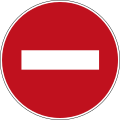






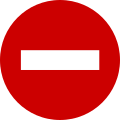












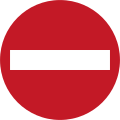











































































![SADC [clarification needed]](http://upload.wikimedia.org/wikipedia/commons/thumb/5/56/SADC_road_sign_R242.svg/120px-SADC_road_sign_R242.svg.png)
















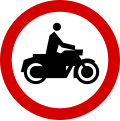

































































































































![United States (also no motor-driven cycles are allowed[1])](http://upload.wikimedia.org/wikipedia/commons/thumb/d/d9/MUTCD_R5-10.svg/100px-MUTCD_R5-10.svg.png)



































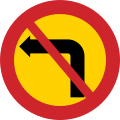

















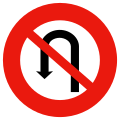


















































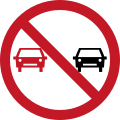















































































![New Zealand [2]](http://upload.wikimedia.org/wikipedia/commons/thumb/4/49/New_Zealand_road_sign_R1-3.svg/120px-New_Zealand_road_sign_R1-3.svg.png)















































